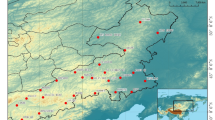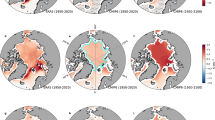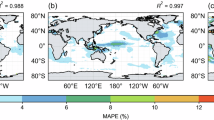Abstract
Reed and Rogers1 have presented amplitudes of the 26-month zonal wind oscillation at various heights and latitudes. Elsewhere, Reed2,3 has presented temperature amplitudes and phases and shown that meridional forces are in geostrophic equilibrium. The purpose of this communication is to present an analytical expression for the zonal wind oscillation which accurately describes the observations and which, through the thermal wind equation, also leads to an accurate analytical expression for the temperature oscillation. These expressions should prove useful in theoretical investigations of the oscillation.
This is a preview of subscription content, access via your institution
Access options
Subscribe to this journal
Receive 51 print issues and online access
$199.00 per year
only $3.90 per issue
Buy this article
- Purchase on SpringerLink
- Instant access to full article PDF
Prices may be subject to local taxes which are calculated during checkout
Similar content being viewed by others
References
Reed, R. J., and Rogers, D. G., J. Atmos. Sci., 19, 127 (1962).
Reed, R. J., Quart. J. Roy. Meteor. Soc., 88, 324 (1962).
Reed, R. J., personal communication (1963).
Author information
Authors and Affiliations
Rights and permissions
About this article
Cite this article
STALEY, D. Wind and Temperature Representations in the 26-month Oscillation. Nature 206, 177 (1965). https://doi.org/10.1038/206177a0
Issue date:
DOI: https://doi.org/10.1038/206177a0



